Three Shared Experiences in Ethiopia
Article and photos by Anita Howard
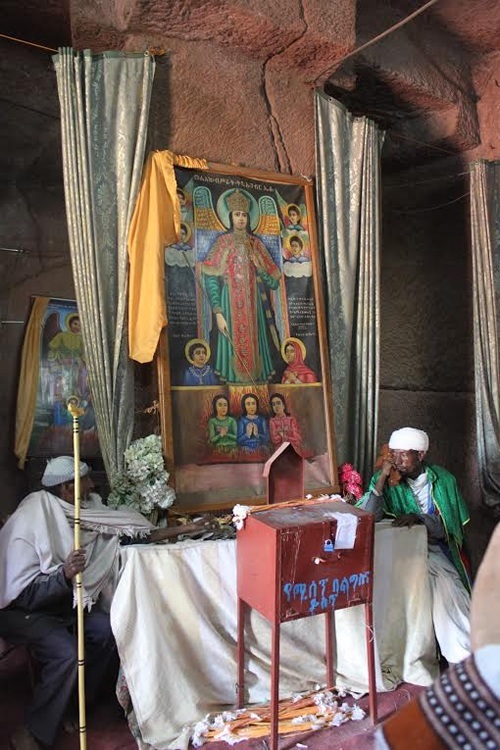
|
|
Priests in Ethiopia sitting on chairs at table with large icon at an altar.
|
1) Painting Together
At peace, I sat on a folded chair by an Ethiopian dry riverbed, my drawing pad on my lap, and at my feet pencils, brushes, and watercolor paints.
My eyes roamed over the dry riverbed flanked by large trees with roots like arms and the fingers of an underground creature reaching down in search of water. The expanse of the blue sky intensified the varied tones and mixtures of oranges, reds, and yellows of the stone barrier.
I intended to capture this vision before me in a semi-realistic watercolor style. So, with a paintbrush loaded with yellow ochre, I became absorbed in the rhythmic relationship between my hand and eyes to capture something of this place.
A man herding cattle looked in my direction. Quickly, I placed the brush in the appropriate colors and attempted to encapsulate his unique facial features. All too quickly, he had walked past. When I looked down, I noticed I had not clearly depicted him. I had presumed what he looked like from too many past portraits instead of looking at the distinctive shapes that made his face unique. I continued with the landscape to study its features more fully when I became aware of someone behind me.
"Hi," I said as I looked up at the face of a young man and quickly took mental note of his distinctive Hamar features. He was one of the Hamar teenagers who did odd jobs around the camping site, such as washing our clothes.
He gave me a nod as he leaned forward towards my painting equipment and artwork. I watched his eyebrows as they furrowed and then relaxed while his fingers twitched. He appeared eager to explore my art equipment.
"Painting the view," I said as I waved my arm in front of me.
He sat down next to me.
Using the paintbrush I had in my hand, I reached forward and dipped the brush into some water, then onto a dry block of blue color. Tearing away a page from my art book, I looked at him, smiled, and then pointed to my painting, the brushes, and the paint. After I handed him the sheet of paper and a brush, I leaned forward and wiped my brush into the now blue fluid, then transferred this blue over the area where I wished to be the sky.
The young man did not wait for me to finish and instead dipped his brush into the water. He chose the yellow color and dripped water onto that block. As he waited for the yellow to become fluid, he wiped his brush through the blue pigment. He initiated his artwork with a confident twist and turn of the brush. The young artist returned to the yellow pigment. However, the pigment changed from yellow to green as he dipped his brush. He turned his head quickly to look at me as he bit his lower lip and raised an eyebrow. I smiled to reassure him that mixing the two colors together was fine. He returned my smile and turned back to his artwork.
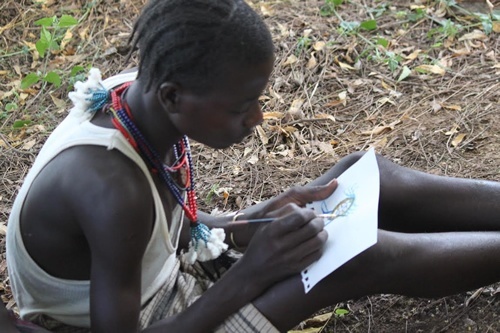
|
|
Young man in Ethiopia sitting on ground and sketching spiritual birds on a sheet of paper.
|
With growing fascination, I watched his strokes become more confident as he transformed the white paper into a collection of colorful creatures, which I later learned represented spiritual birds. He did not paint so much in a realistic but a personal style. As the afternoon progressed, so did the colors before us. In silence, we continued to express what this landscape spoke to each of us, using our own technique. I wondered if I had awakened something in this young man. I asked what he might create later in his life.
The next afternoon, when I started painting again, he joined me. This time, he had brought a friend with a sheet of graph paper in his hand, which appeared to have been roughly torn from an exercise book. With a twinkle in his eyes, the new young man held the paper out for me to see as an apparent demonstration that he, too, was an artist. Next, he leaned forward and gestured to my brushes and paint. He followed up by lightly brushing over his drawing with his fingers. His drawing depicted the campsite in what the "Art World" might label as a "naive style." However, his art was not naive at all, as I saw it, and revealed his keen eye for detail.
I smiled and nodded for the teenagers to sit and share my painting materials. Without a pause, the teenager I met the day before demonstrated how to make the dry blocks of color into colorful fluids to his friend. I thought of the arrogance of some "experts" in the "art world" to categorize art styles through their arbitrary and biased aesthetic judgments. I recalled the manner of color selection and placement used by the teenager yesterday — no one who saw his work could doubt the sincerity and conscious application used — to paint what I would describe as a beautiful yet unrecognizable series of birds.
For the rest of the afternoon, the three of us sat next to each other on the banks of the dry riverbed. Yet we were each in our own world and in conversation with the surrounding environment. We transformed white pages into varied expressions of this place in our own style. There was no competition or judgment, as each of us respected the different aesthetics that were our own as artists.
At one stage, I stopped and watched the boys absorbed in the motion of painting their ideas. I reflected on other times that I had sat with artists in different locations worldwide. I sat with various people in Ethiopia and experienced a unique and unforgettable bond.
2) Observing Baboons in the Mountains
of Northern Ethiopia
In the Simien Mountains of Northern Ethiopia, I was part of a group walking through awe-inspiring landscapes. We experienced an unplanned chance to sit amongst a group of wild baboons. People can live and farm; however, wildlife must never be harmed. The result of custom and circumstance led to an entertaining experience for our group.
The baboons were spread over the immediate area in groups of varying sizes. They reminded me of "human gatherings." There were groups of females with babies, young male or female groups, the more elderly, and many young baboons who moved between these different groups. The young baboons often stopped to wrestle with each other, pick up a stick to use as a toy or annoy a young mother with her baby. In response, older baboons would chastise the youngsters with a wallop, bared teeth, or verbal onslaughts.

|
|
A family of baboons sitting under a tree in Ethiopia.
|
In a surreal moment, my traveling companions and most of the baboon tribe sat and watched as two women attempted to stop specific baboons from invading their vegetable gardens and racing off with their crops. The garden was laid out as a very long strip. The appointed baboons are divided into two groups at the top and bottom of the garden. One group of baboons advanced in the garden, making all types of noises. The women ran to one end and waved sticks to defend their garden, making quite different noises. The women ran to one side, allowing the other baboons to quietly enter the unprotected garden and steal some crops. The women's attention was alerted to this theft by the vocal enthusiasm of some of the baboon audience. The women then ran to the now-invaded end, waved, and shouted, allowing the baboons another chance to steal crops from the now-abandoned section.
Some baboons strolled past us as we sat still and enjoyed this spectacle. They often stopped about a meter in front to look at us. With a baby holding on tight to her mother's abundant hair, one female stopped about a meter before me as she scratched her head above her eyes. Her eyes met mine, and we exchanged a deep gaze. At that moment, this exchange of glances expressed an understanding, from one female to another, that many of our concerns were shared. I watched her move on with her baby, tugging her ears to demand her attention. I recalled my time as a mother of young children and the delights and demands of that responsibility.
I sat in wonder of the skillful manner by which the baboons had outsmarted the farmers, as well as their confidence to stride closely amongst us. Ironically, it felt as though we were the caged ones (due to the direct instructions from our guide). I don't know what they thought of us; maybe they were as curious about us as we were of them! I, for one, did not feel in danger or unwelcome.
3) The Rituals of the Coptic Christians at Christmas
The Coptic Christians in Lalibela, Northern Ethiopia were especially welcoming. At approximately 11:50 p.m., January 7, during the Ethiopian Coptic Christmas Eve, I sat upon a cloth I had been invited to share. My hosts were Ethiopian pilgrims, and there was no common language. Yet, we sat together at the cliff edge that surrounded the stone-hewn church of Bet Maryam. It was a great honor to be invited to a Christmas ritual dating back centuries.
On the areas surrounding the rocky ledge and the base level around the church was a blanket of pilgrims clothed in white (a sign of purification for Holy Christmas). At the stroke of midnight, most of them carried a Bible along with an Order of Mass in their lap. With a torch or candle, they followed the Mass that commenced at the base of the church, Bet Maryam. A priest stood on the cliff to instruct us to repeat the words of the Mass in progress below. He would sometimes signal everyone to join the chanting, often followed by the ululation "Lalala." This is the recognizable sound made by women from many different cultures. Tongues moved rapidly back and forth in their mouths while producing high-pitched sounds. As a belly dancer in the past, I knew how to create this very effect, and so I joined in when appropriate. Such participation increased my hosts' pleasure and pride; I was then offered more space on the cloth and some food.
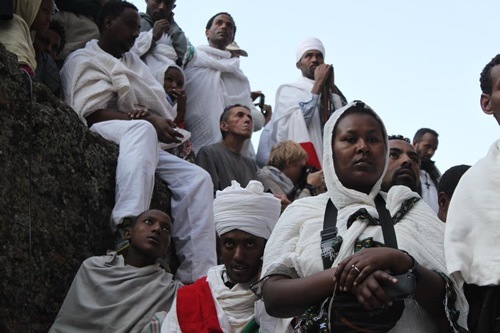
|
|
Religious members dressed in white sitting on ledges in Lalibela.
|
After some time together watching the sacred ceremony below, I said my thanks and indicated that I needed some sleep. Returning a few hours later, I went to the same cliff edge and was warmly welcomed. However, they were less keen for me to join them this time. They had unique plans for me. One of the young men led me down along the cliff edge to what I later discovered was the "best seat in the house."
As the sun appeared, over a hundred priests walked up a path just below where I was sitting. The priests continued their march until they encircled the entire rim of the cliff. Each priest wore a white turban and carried golden scarves. Some were colorfully dressed and had their white robes adorned with red sashes stitched into the hems. Some priests carried enormous icons, while others held drums or sistras. Periodically, the sound of drums started up. All the priests chanted and very slowly swayed in unison. Many Ethiopians at the ceremony would start to chant in response.
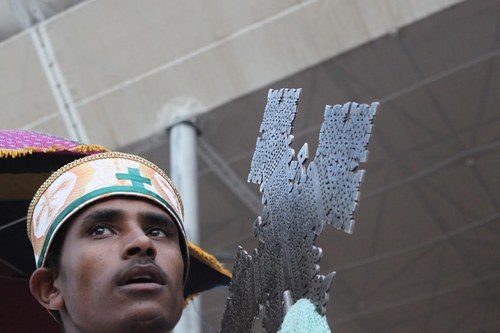
|
|
Scenes of religious processions and rites in Lalibela.
|
Around and below me, surrounding the entire church, was an endless mass of white-clothed people. All were standing, very tightly packed together, for a ceremony that lasted about two hours. There was no pushing or complaining, just a sense of spiritual togetherness. During this powerful and moving Christmas celebration, many enjoyed participating in the service and documenting their experience in Lalibela. At one stage, I stretched dangerously forward to get a photograph of the high priests seated to my right. A few Ethiopians below became very concerned. One man kindly offered to take some pictures for me from his vantage point, offering a very clear view of the priest. In return, I took a group photograph of him with his friends.
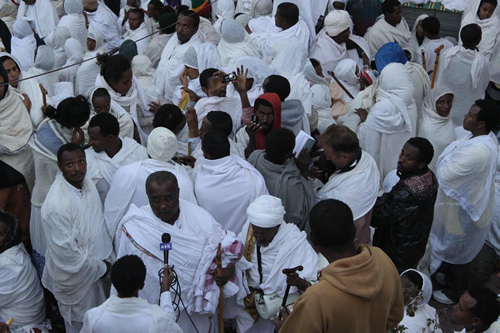
|
|
Religious worshippers in white in large crowdsd rites in Lalibela.
|
As we walked back to our hotel after an inspiring and uplifting experience, I asked our tour guide,
"Now that the ceremony is finished, what would these pilgrims do to celebrate the rest of Christmas day?"
"They walk home, some will take a few days to get to their village," he responded
"‘What, no meal, presents, and such?" I asked
"No," he said
I recalled my family's Christmas rituals; some would go to church, followed by an over-abundance of food and drink and exchanging gifts, often not really needed. Here, I had sat and been amongst people whose faith and rituals were so intertwined that they saw no reason to change the focus for this day to be similar to ours. Instead, I needed to reexamine and refocus on what Christmas truly meant to me.
The following morning, our tour group explored the stone churches we had not previously visited. Unlike previous days leading up to the ceremony, we did not have to squeeze our way in and around the Mass of pilgrims that had filled the churches. We could stop and appreciate the ancient frescoes alongside more contemporary icons.
Our ideas, aesthetics, and rituals often define who we are. As individuals, we realize that we can choose to hold on tightly to our own perspectives or immerse ourselves in the life and culture of those around us. We can relax and learn to appreciate how new perspectives evolve while enjoying the experience and culture of others. One of the most inspiring and precious aspects of travel is the plasticity of options, where every visit, every moment, so often becomes precious and unique in its own right.
Anita Howard has traveled to many places as a tourist and a volunteer teacher. She documents what she sees and experiences through art and text as she travels. These experiences have initiated a series of stories for mid-grade children, where, through magic, three children travel to real places around the world. There, they have an adventure and gain insight into themselves and others. Anita lives in Australia with her cat in a house where the magic emanates.
|
